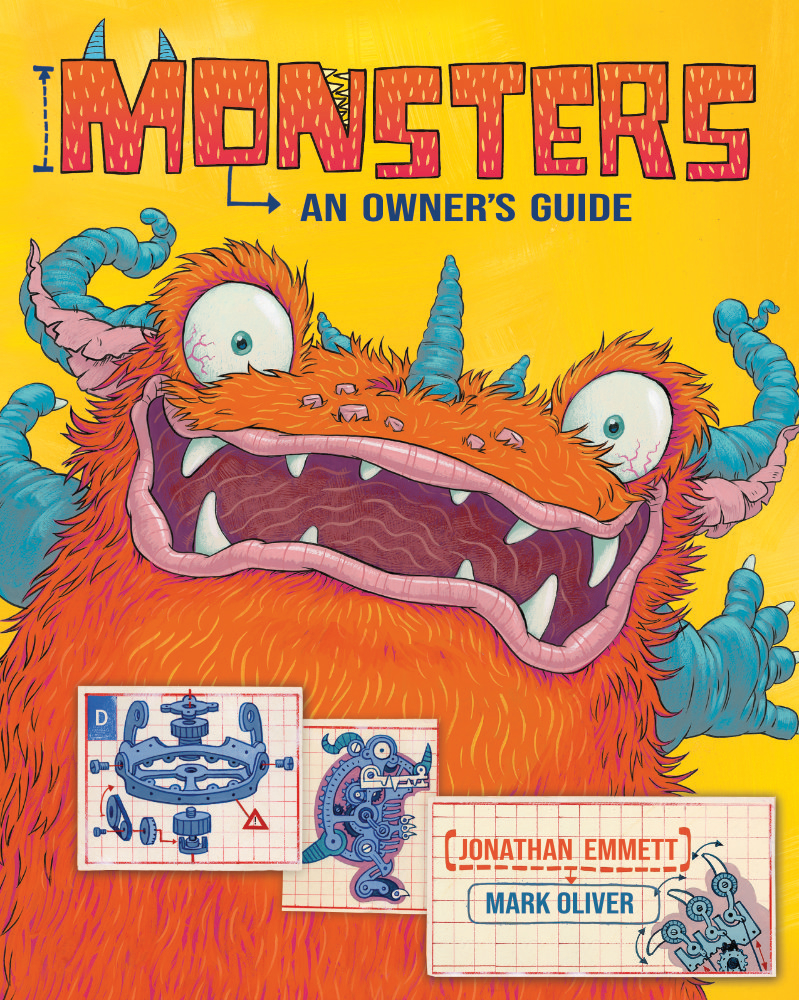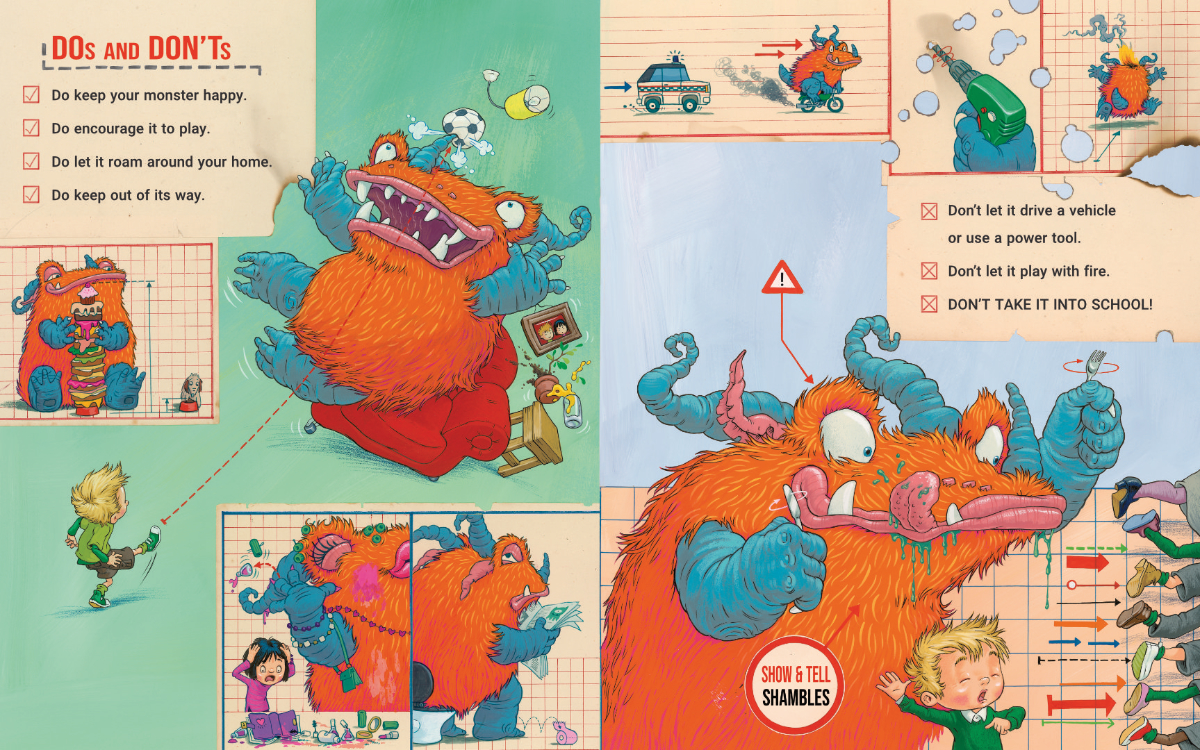
An Owner’s Guide
illustrated by Mark Oliver
With a Monstermatic toy you can experience the thrill of caring for a huge, half-crazed creature in the comfort of your own home.
This guide contains all you need to know about assembling and operating your monstrously marvellous companion!
Winner of the KS1 category of the
STOCKPORT SCHOOLS’ BOOK AWARD 2011

After finishing Tom’s Clockwork Dragon, illustrator Mark Oliver got in touch with me to say how much he’d enjoyed illustrating that story. I was very pleased with Mark’s pictures for that book, so we resolved that we should try to do another book together.
Rather than leave it to chance, I asked Mark if he had any suggestions for the sort of book he’d enjoy illustrating and about a month later he sent me an email with some ideas. These ranged from a couple of words like “Flying Machines” to detailed outlines, but it was the following suggestion that immediately took my fancy.
“Mechanical Monsters. Imagine if all monsters were really machines, covered in skin, feathers or scales. They would occasionally break down. Surely all monster-owning children would require a repair manual. A kind of Haynes Manual for individual monsters. ‘The Gryphon Growler MkIII’. Also includes instructions on customization (a kind of Pimp my beast).”
I thought this was a great idea. I could imagine a monster repair manual having a similar appeal to the Thunderbirds and Star Wars cross-section books packed with technical detail that many children love to pore over. However when I sat down and tried to write a picture book along these lines I struggled to do it. I realised that one of the things that makes those technical cross-section books appealing is that the reader is already familiar with the machines they are exploring. A child looking at a Star Wars cross-section book will already know what the Millennium Falcon is and its role in the Star Wars films. Whereas the monsters depicted in our repair manual would be unfamiliar to the reader, so their internal workings would not be as interesting.
I decided that a solution to this problem would be to incorporate a story featuring mechanical monsters alongside the technical content of the repair manual. I worked on several story ideas including one set in a factory where monsters were made, one in a garage where they were repaired and one about a traveling monster repairman, but none of them seemed very appealing so I ended up putting the project aside.
However I couldn’t get the idea out of my head and so a few weeks later I picked it up and tried to find a fresh angle. Mark’s original suggestion had said that the manual was for a child, but why would a child have a mechanical monster? One answer was that the monster was some sort of interactive toy. Most interactive toys come with a user’s guide and I realised that this type of book, which described how the monster could be used around the home, would be a better basis for a picture book than a repair manual.
A search of the internet produced lots of user’s guides for toys and other products. One good source was the web site of Wowee, who make many interactive toys including the popular Robosapien. I read through lots of manuals by different manufacturers to get a feel for the writing style and organisation. You’d be amazed by how many manuals actually do start with the stock phrase “Congratulations on your purchase,” and they nearly all end with a guarantee page.
The writing style of most user guides is not very engaging, so to make this book more appealing I decided to set it in rhyme. I’ve written lots of rhyming texts and let me tell you, writing rhyme that scans well, makes sense and provides an opportunity for appealing illustrations is difficult enough. Writing rhyme that does all this while spoofing the style of a user manual proved almost impossible and I abandoned the first draft several times to pursue less-challenging projects before it was completed.
I eventually got a draft I was happy with and sent it to Mark. Fortunately he loved it and immediately set to work on some character sketches.
Mark went through several prototypes before arriving at the monster that appears in the book.
Although I’d given the book a simple plot, this had to be conveyed entirely by Mark’s illustrations; the only text in the book being that of the user manual. As you read through the manual describing how the mechanical monster is meant to function, the illustrations show an actual monster being delivered, assembled and then behaving in an increasingly chaotic manner.
We showed the text and some of Mark’s initial sketches to a couple of publishers and Emily Ford at Macmillan accepted the project after Mark did some further work on the character designs. I’d originally suggested the book showed a family – mum, dad and a young son – interacting with the monster, but one of the changes we made at this point was to drop the parents and have an older sister fulfilling a similar role.
Instead of simply showing pages from the manual opposite illustrations of the children with the monster, Mark decided to blend the two elements together so that it appears as if text and diagrams have been cut out of the manual and stuck onto the illustrations.
This resulted in some complex spread layouts so Mark hammered out all the details in a series of drawings ranging from thumbnails (small rough sketches) through to very detailed pencil drawings.
Mark sketched up each of the spreads several times in increasing detail before creating the finished versions.
For the final artwork, Mark created the excerpts from the manual on separate pieces of paper, cutting, staining, tearing and even burning the edges of some of the pieces before combining them with the painted illustrations. As you go through the book, you can see that the pieces of the manual get progressively more tatty as the monster’s behaviour gets more destructive.
It’s unusual for an author an illustrator to collaborate so closely on a picture book, so we’re very grateful to Emily* and everyone at Macmillan for giving us the opportunity and for helping marshal our monstrous ideas into a presentable form. Both Mark and I are tremendously proud of the result!